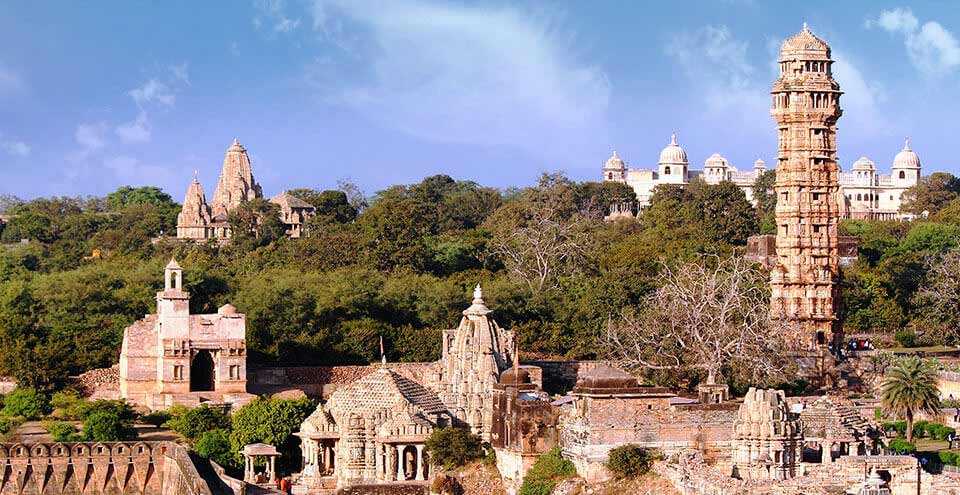Chittorgarh, a historic city in Rajasthan, is a treasure trove of architectural wonders, ancient forts, and captivating tales of bravery and valor. The city’s grandeur and rich cultural heritage are showcased in its many monuments and sites, making it a must-visit destination for history enthusiasts and travelers alike. Here are the 12 best sightseeing places in Chittorgarh you should definitely explore:
1. Chittorgarh Fort
The crown jewel of the city, Chittorgarh Fort, is one of the largest forts in India. A UNESCO World Heritage site, it stands as a symbol of Rajput pride and valor. Spread over 700 acres, the fort houses numerous palaces, temples, gates, and reservoirs. The fort’s history, especially its association with Rani Padmini and the battle against the Mughal forces, is legendary.
2. Rani Padmini Palace
Located inside Chittorgarh Fort, Rani Padmini Palace is where the beautiful Queen Padmini resided. The palace has an iconic structure and is surrounded by a shimmering lake. It is famously known for the tale of Padmini’s bravery and self-sacrifice during the siege of the fort by Alauddin Khilji.
3. Vijay Stambh (Victory Tower)
This 37-meter high tower was built by Rana Kumbha in the 15th century to commemorate his victory over the combined forces of Malwa and Gujarat. The tower is adorned with intricate carvings and sculptures depicting Hindu deities and is an architectural marvel.
4. Kirti Stambh (Tower of Fame)
Dedicated to the Jain Tirthankaras, this 22-meter high tower is an example of Jain architecture. Located near the Chittorgarh Fort, it is a peaceful and less-crowded site that showcases beautiful carvings and sculptures.
5. Meera Temple
A temple dedicated to the great saint and poetess Meera Bai, who was an ardent devotee of Lord Krishna. The temple is known for its beautiful murals and inscriptions. It offers a glimpse into the spiritual history of Chittorgarh.
6. Kalika Mata Temple
Located at the summit of the Chittorgarh Fort, Kalika Mata Temple is dedicated to Goddess Kali. It offers stunning views of the city and is an important pilgrimage site for Hindus. The temple’s historical significance and scenic surroundings make it a popular stop.
7. Fateh Prakash Palace
Once the residence of the Mewar rulers, Fateh Prakash Palace is an architectural marvel with regal rooms, courtyards, and sprawling gardens. The palace has now been converted into a museum showcasing artifacts and items from Rajasthan’s royal history.
8. Padmini’s Palace and the Reflecting Pool
This is the palace where Rani Padmini is believed to have performed the “jauhar” (self-immolation) to protect her honor. The reflecting pool, located outside the palace, mirrors the grandeur of the structure and adds to its mystique.
9. Brahmanical Temples
Chittorgarh is home to numerous ancient temples dedicated to Hindu gods and goddesses. The Jain and Brahmanical temples inside the fort are beautiful examples of medieval Indian architecture and offer a glimpse into the region’s religious history.
10. Gaumukh Reservoir
Located near the fort, Gaumukh is a natural spring that flows from a rock carved in the shape of a cow’s mouth. It is a peaceful spot surrounded by nature, perfect for a quiet retreat after visiting the fort.
11. Rana Kumbha Palace
A stunning example of Rajput architecture, the Rana Kumbha Palace is believed to be the birthplace of Maharana Udai Singh, the founder of Udaipur. The palace’s ruins still showcase impressive structures and offer a view into the region’s royal past.
12. Chhatris (Cenotaphs)
The chhatris or cenotaphs in Chittorgarh are commemorative structures built in honor of Rajput rulers. These beautiful, intricately carved structures can be found around the fort and are a testament to the valor and sacrifice of the region’s warriors.
